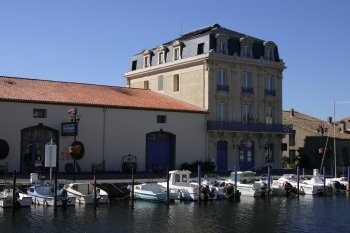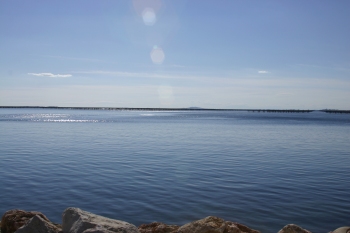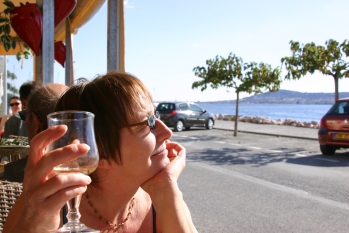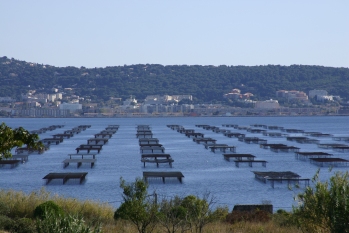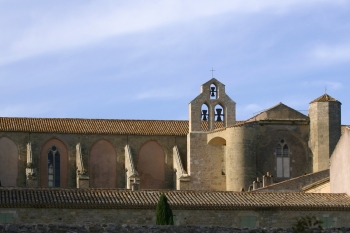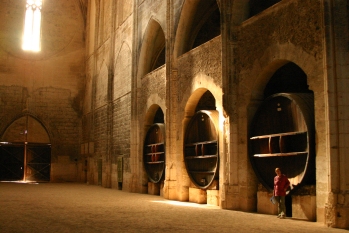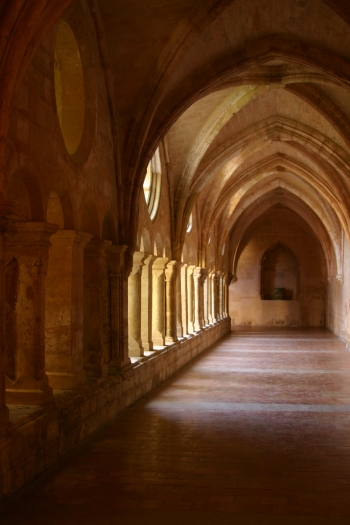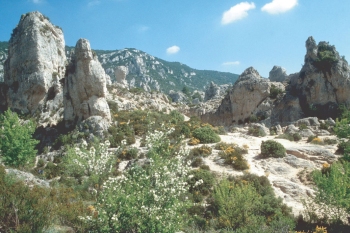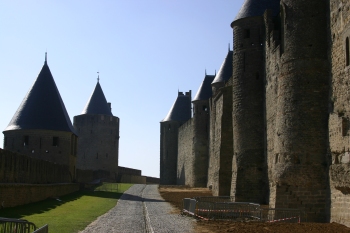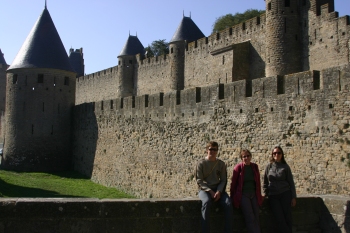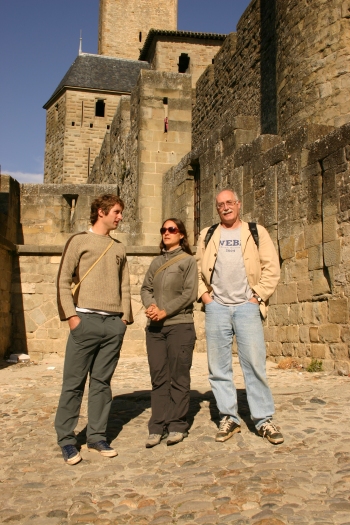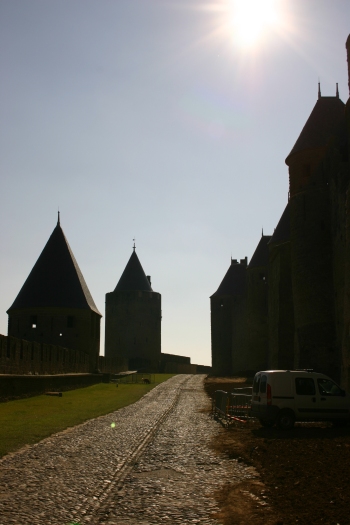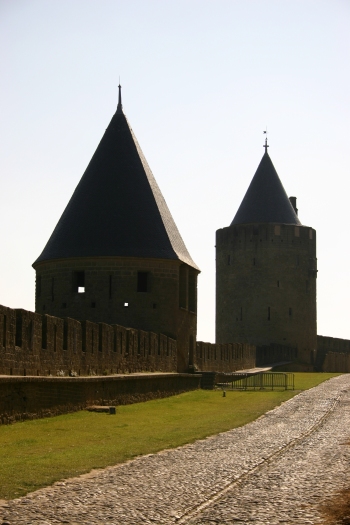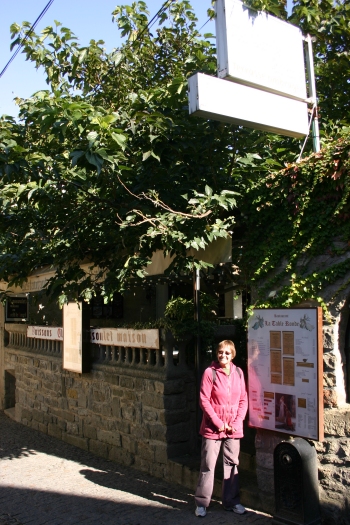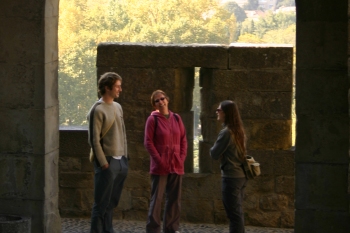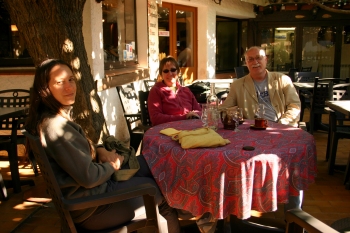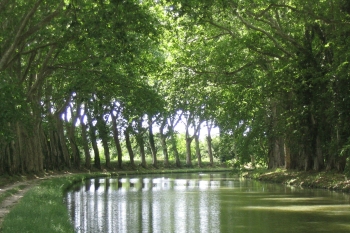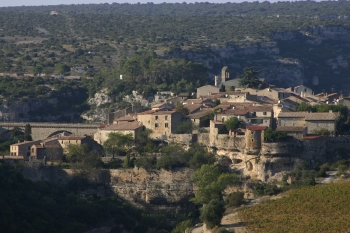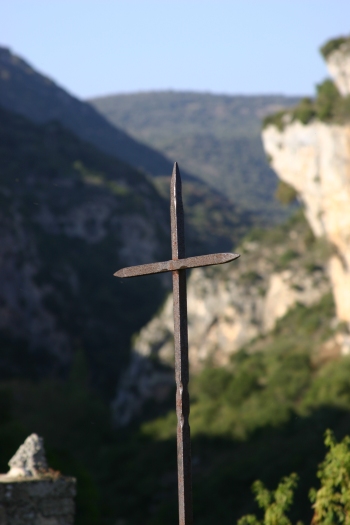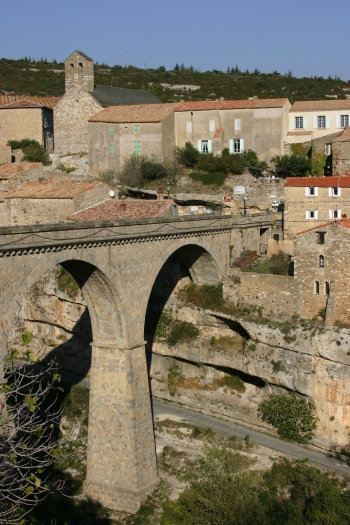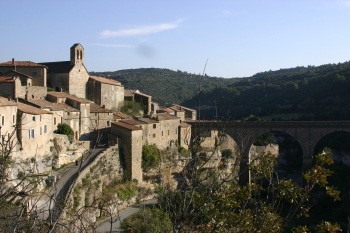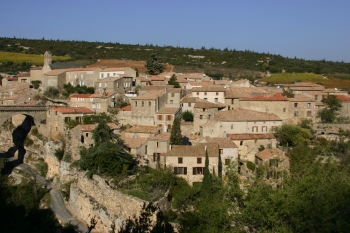The Befouled Weakly News
4 November 2007
- A Foray to France (Part Two)
And so, on to Day Three which saw Ms Playchute and I on a leisurely excursion out to Marseillan, Balaruc-les-Bains, and the incredible Abbaye de Valmagne. Marseillan is an ancient Greek Phoenician town, founded in the 6th century BC which, apparently, the local population refer to simply as Paradis sur Terre (heaven on earth). It has kept the authentic character of a fishing village on the shores of the Mediterranean and the Bassin de Thau, which is famous for its cultivation of oysters and mussels. It also happens to be the site of the mouth of the Canal du Midi which we drove along for some time later in the week as well as being the home of Noilly Prat, a well-known (to some of you at any rate) dry vermouth first developed in 1813 by Joseph Noilly. Since neither of us are great fans of vermouth, we gave the distillery a miss and, having strolled around the port for a while, wended our way toward Balaruc-les-Bains for a spot of lunch.
Balaruc-les-Bains is, again, on the Bassin de Thau and as we drove along the coast we could see the rows and rows of oyster “tables” which are used for growing the oysters. Baby oysters from Indonesia are cemented to the tables which are then lowered into the seawater. They develop and grow and, when mature, can be conveniently harvested. When necessary, the tables can be covered to protect the oysters underneath from too much glare and heat. The front in Balaruc-les-Bains is littered with restaurants and, although the one Joe recommended was closed (the season was definitely on the wane when we were there) as they were all serving oysters fresh out of the Bassin it made little difference. We found one with a lovely view and I ordered the shellfish platter which consisted of a dozen oysters, half a dozen scallops, and a handful of mussels. As many of you will know, Ms Playchute is not particularly enamoured of shellfish so she settled for a very nice piece of salmon. A pitchet of the local white wine, Picpoul de Pinet rounded out the meal in a most satisfactory manner!
Our next stop was the Abbaye de Valmagne which was founded in the 12th century by Raymond Trencavel, Viscount of Béziers. It was one of the richest abbeys in the south of France for several hundred years until first the Huguenots and then the French Revolution brought it close to complete ruin. At the Revolution in 1789, the last five monks fled just ahead of rebellious peasants who invaded and ransacked the abbey, burning precious documents, furniture and works of art. Confiscated as a national property, the abbey was sold in 1791 to Granier-Joyeuse who turned the church into a wine cellar, with the addition of huge vats in the nave and absidals chapels, thus preventing the abbey from becoming a stone quarry, as was the fate of so many abbeys.
The Abbaye was fabulous and the sight of the gigantic wine vats in the nave is quite disconcerting. The tranquillity was marvellous and, merely in order to be polite you understand, we found ourselves tasting and thus purchasing some of the wine, and very nice it was too. Day Four saw us on another of Joe’s bike rides, this time heading to the north of Caux through the villages of Fontes and Lieuran-Cabriéres before making the first of several wrong turns. (As you can deduce, Joe did not accompany us on this outing and, in spite of having a detailed map of the area, we, or rather I, failed miserably in spotting a turn. As a result, we unnecessarily added about twenty kilometres to our outing but that did give us the chance to ride through Nébian and Clermont l’Hérault which we would otherwise have missed. Having said that, there was nothing of any particular significance in either so the extra kilometres were just that – extra kilometres!)
After our false detour through Clermont l’Hérault we made our way via a circuitous but very scenic route to the Cirque de Mourèze, another natural phenomenon. The Cirque has been occupied since prehistoric times, and consists of large numbers of strange standing rock formations, worn by rain over millions of years, which emerge from the undergrowth in the forms of various beasts and structures. It’s a very popular area for walkers and climbers but Ms Playchute and I, being somewhat tardy due to our detour, had little opportunity other than to look, mount our bikes and head for home. We had a pressing appointment with Joe, Amandine and visits to a couple of vineyards for some wine tasting. Back in Caux, suitably exhausted, Penelope and I had a quick shower and change and we were off again, this time to the Appellation d'origine Controlee region of Faugeres just to the southwest of Caux. Joe had very kindly organised a couple of private wine tastings at three vineyards and it was a fascinating experience. Joe had to provide a detailed translation service but the explanation of the ethos of each of the domains was very interesting (and the wine was half decent as well). We ended up buying about two cases altogether which, as we speak, are still in Caux awaiting transportation back to the UK when the French Cycling vans make their annual pilgrimage home. They’ll be all the more tasty when they finally materialise. Wednesday, Day Five, saw us driving with Joe and Amandine down to the magnificence of Carcassonne and then, via a very circuitous but most enjoyable route, back to Caux by way of Minerve meandering at various stages alongside the very picturesque Canal du Midi.
Carcassonne, as Dad and Mom (and the boys, perhaps) will remember, is simply stunning – a fairy tale fortified town which stands on a hill which dominates the region. It stands in the gap between the Pyrenees and the Massif Central and, as such, is at the crossing of two major traffic routes in use since Antiquity: the route leading from the Atlantic to the Mediterranean and that from the Massif Central to Spain, skirting the Pyrenees.
The Romans started it all when they fortified the hilltop around 100 BC. The Visigoths added more fortifications which assisted in their success in resisting attacks by the Franks. After many other incidents, it was taken in 1209 by the crusading army of Simon de Montfort who added additional fortifications which made the fortress virtually impregnable. During the Hundred Years' War, Edward the Black Prince failed to take the city in 1355, although his troops destroyed the Lower Town.
In 1659, the Treaty of Pyrenees transferred the border province of Roussillon to France, and Carcassonne's military significance was reduced. It was struck from the roster of official fortifications under Napoleon and the Restoration, and the fortified cité of Carcassonne fell into such disrepair that the French government decided that it should be demolished. A decree to that effect in 1849 caused an uproar and a campaign was mounted to preserve the fortress as an historical monument. The architect Eugène Viollet-le-Duc was commissioned to renovate the place. The restoration was strongly criticized even during Viollet-le-Duc's lifetime. Fresh from work in the north of France, he made the error of using slates and restoring the roofs as pointed cones, where local practice was traditionally of tile roofing and low slopes, in a snow-free environment. The fortress, was added to the UNESCO list of World Heritage Sites in 1997. When we visited Carcassonne with Dad and Mom we had a fabulous dish of Cassoulet which Penny was very anxious to repeat. Cassoulet is, as you will probably know, a rich, slow-cooked bean stew or casserole originating in the southwest of France, containing meat (typically pork sausages, pork, goose, duck and sometimes mutton), pork skin and white haricot beans. Would the same restaurant still be there nearly twenty years later serving the same, delicious Cassoulet? Fortunately, I had a vague recollection of where the restaurant had been located and, upon describing it to Joe, we made our way directly there. It was as delicious as it had been all those years ago and, for future reference, the restaurant is somewhat tackily named, “The Round Table”.
After our Cassoulet, we spent a happy hour or so wandering through the streets of the cité and strolling along the ramparts soaking up the atmosphere. Eventually we found our way back to the car and back on to the road again. This time, following Joe’s navigation, we travelled along a number of smaller roads toward Caux via Minerve and, at various points alongside the Canal du Midi. The Canal du Midi is the oldest working canal in the world, a magnificent feat of seventeenth century engineering. It is a beautiful and tranquil waterway, connecting the Atlantic Ocean to the Mediterranean Sea. The Roman emperors Nero and Augustus had both thought about such a canal. So did Charlemagne, and the kings François I, Charles IX and Henri IV. The advantages of avoiding the sea voyage around Spain were considerable: a tenth of the distance, no storms, and no piracy. Each ruler in turn commissioned a study, and some even started work, but none came anywhere near succeeding. Apart from anything else the canal would have to rise to almost 200 metres above sea level. In the seventeenth century an exceptional man came up with another plan. He was Pierre Paul Riquet, Baron de Bonrepos, a Royal Judge with the right to collect taxes in the Languedoc. Already almost 60 years old, Riquet persuaded Louis XVI in 1663 that a canal to join the Atlantic to the Mediterranean Sea was technically feasible, using water feeds from the Montagne Noire. Work began in 1666. Riquet started on his greatest work by commissioning his engineer, François Andreossy to build a huge dam at Saint Ferréol on the Laudot river, a tributary of the River Tarn in the Montagne Noire some 20km from the summit of the proposed canal at Naurouze. This massive dam, 700 meters long, 30 meters above the riverbed and 120 meters thick at its base was the largest work of civil engineering in the century in Europe. This was Riquet's unprecedented plan to supply the canal with water. He connected this to the summit with a contoured channel 3.7m wide with a base width of 1.5m and even constructed 14 locks in it in order to bring building materials for the canal. The whole project took 14 years. Riquet was a model employer, taking care of the health and wellbeing of his 12,000 or so workers. The responsibility put a great strain on his health, and he died a few months before the canal was completed. He had used his own fortune, and dedicated his life to it. It was officially opened in 1681. Leaving the Canal du Midi we made our way up into the hills and then down into the gorge carved by the River Cesse to Minerve, described as the most beautiful village in France.
Minerve is a fortified medieval village, with many of the fortifications still in place, perched high above a canyon in the barren Languedoc landscape. In 1210 a group of Cathars, having escaped from Béziers, found refuge in the heavily fortified village. The village was protected by a double curtain wall, and overhanging natural ledges; but this did not stop Simon de Montfort's crusader army. They set up four catapults around the fortifications: three to attack the village, and the largest to attack the town's water supply. Following a six-week siege, Minerve was forced to surrender to the Crusaders on 22 July 1210. Guilhem of Minerve saved the villagers but he could not save the Cathars who had taken refuge in the town. Some 150 to 180 Cathar Parfaits were burned alive when they refused to renounce their faith.
And so finally, back to Caux after another great outing. Next week we’ll wrap up with a description of our final day’s expedition to the Abbaye Lagrasse, the Chateaux de Quéribus and Peyrepertuse, our winding drive through the unbelievably narrow Gorges de Galamus and finally lunch in Tautavel while searching for the Butler’s Mas. Love to you all, Greg At the urging of his doctor, John moved to Arizona. After settling in, he met a neighbor who was also an older man. "Say, my doctor recommended I move here for my health. Is this really a good place to live?" "It sure is," the man replied. "When I first arrived here I couldn't say one word. I had hardly any hair on my head. I didn't have the strength to walk across a room and I had to be lifted out of bed." "That's wonderful!" said John. "How long have you been here?" "I was born here." A young boy came to Sunday School late. His teacher knew that he was usually very prompt and asked him if anything was wrong. The boy replied no, that he was going fishing but his dad told him that he needed to go to church. The teacher was very impressed and asked the boy if his dad had explained to him why it was more important to go to church than to go fishing, To which the boy replied, yes he did, dad said he didn't have enough bait for both of us. I think we’ve probably had it before but what the heck? A man standing in line at a check out counter of a grocery store was very surprised when a very attractive woman behind him said, "Hello!" Her face was beaming. He gave her that "who are you look," and couldn't remember ever having seen her before. Then, noticing his look, she figured she had made a mistake and apologized. "Look," she said "I'm really sorry but when I first saw you, I thought you were the father of one of my children," and walked out of the store. The guy was dumbfounded and thought to himself, "What is the world coming to? Here is an attractive woman who can't keep track of who fathers her children!" Then he got a little panicky. "I don't remember her," he thought, but MAYBE… during one of the fraternity parties he had been to when he was in college, perhaps he did father her child! He ran from the store and caught her in the parking lot and asked, "Are you the girl I met at a party in college and then we had a little too much to drink and spent the night together but I never called you again afterward?" "No", she said with a horrified look on her face. "I'm your son's Sunday School teacher." Back to the Befouled Weakly News Back to Greg's Temporary Home Page
|
||||||||||||||||||||||||||
